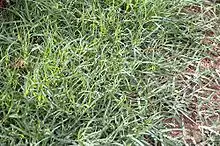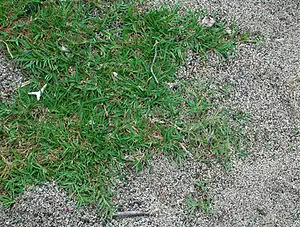Cynodon dactylon
Cynodon dactylon, commonly known as Bermuda grass, is a grass found worldwide. It is native to Europe, Africa, Australia and much of Asia. It has been introduced to the Americas.[2][3] Contrary to its common name, it is not native to Bermuda and is in fact an abundant invasive species there. In Bermuda it has been known as "crab grass" (also a name for Digitaria sanguinalis). Other names are Dhoob, dūrvā grass, ethana grass, dubo, dog grass, dog's tooth grass,[4] Bahama grass, crab grass, devil's grass, couch grass, Indian doab, arugampul, grama, wiregrass and scutch grass.
| Cynodon dactylon | |
|---|---|
 | |
| Scientific classification | |
| Kingdom: | Plantae |
| Clade: | Tracheophytes |
| Clade: | Angiosperms |
| Clade: | Monocots |
| Clade: | Commelinids |
| Order: | Poales |
| Family: | Poaceae |
| Genus: | Cynodon |
| Species: | C. dactylon |
| Binomial name | |
| Cynodon dactylon | |
| Synonyms[1] | |
|
List
| |
Description

The blades are a grey-green colour and are short, usually 2–15 cm (0.79–5.91 in) long with rough edges.[5] The erect stems can grow 1–30 cm (0.39–11.81 in) tall. The stems are slightly flattened, often tinged purple in colour.
The seed heads are produced in a cluster of two to six spikes together at the top of the stem, each spike 2–5 cm (0.79–1.97 in) long.[5]
It has a deep root system; in drought situations with penetrable soil, the root system can grow to over 2 metres (6.6 ft) deep, though most of the root mass is less than 60 centimetres (24 in) under the surface. The grass creeps along the ground with its stolons, and roots wherever a node touches the ground, forming a dense mat. C. dactylon reproduces through seeds, stolons, and rhizomes. Growth begins at temperatures above 15 °C (59 °F) with optimum growth between 24 and 37 °C (75 and 99 °F); in winter, the grass becomes dormant and turns brown. Growth is promoted by full sun and retarded by full shade, e.g., close to tree trunks.
Cultivation
Cynodon dactylon is widely cultivated in warm climates all over the world between about 30° S and 30° N latitude, and that get between 625 and 1,750 mm (24.6 and 68.9 in) of rainfall a year (or less, if irrigation is available). For example, it is grown in the U.S. mostly in the southern half of the country.
Uses
Religious
Commonly known as "durva" or dūrvāyugma in India, this grass is used in the Ayurveda system of medicine.[8] Performing Puranokta Rudrabhisheka while offering durva 11 times bestows long life. In Hinduism, it is considered important in the worship of Lord Ganesha. A clump of 21 shoots of this grass is usually offered during puja (worship). It has been a part of Hindu rituals since Vedic times. A unique festival called Durga Ashtami, dedicated to this grass, is celebrated on the 8th day of Shukla Paksha of Bhadra month of the Hindu calendar.[9]
It is known as "Arugampul" in Tamil and "Karuka" in Malayalam and is part of the Dashapushpam (Ten sacred flowers) in Kerala.[10]
In Nepal, the grass is known as "dubo" and is used by the Hindus. According to Nepalese Hindus, the grass symbolises long life. The grass is an essential item for the Naga Panchami festival as well as the Gaura festival.[11][12][13] In a Nepalese Hindu wedding, a garland made of this grass is worn by both bride and groom.[14]
This grass is a Yoruba herb used for Esu or Elegba in the Ifá system of orishas.
Medicinal value
The rhizomes are reported to act as a diuretic in humans and the grass juice can act as an astringent.[8]
It has been observed that Cynodon dactylon may be selectively eaten by dogs to swiftly induce vomiting when they have gastrointestinal problems. The effect may be due to irritation caused by bristles on the leaf margin.[8]
Other
It is fast-growing and tough, making it popular and useful for sports fields, as when damaged it will recover quickly. It is a highly desirable turf grass in warm temperate climates, particularly for those regions where its tolerance to heat and drought enable it to survive where few other grasses do. This combination makes it a frequent choice for golf courses in the southern, southeastern U.S and South Africa. It has a relatively coarse-bladed form with numerous cultivars selected for different turf requirements.
Bermuda grass has been cultivated in saline soils in California's Central Valley, which are too salt-damaged to support agricultural crops; it was successfully irrigated with saline water and used to graze cattle.[15][16]
Professional sports
National Football League
The following National Football League teams use it as the playing surface in their home stadiums:
- Arizona Cardinals (State Farm Stadium in Glendale, Arizona) (Tifway 419 Hybrid Bermudagrass)
- Baltimore Ravens (M&T Bank Stadium in Baltimore) (Tifway 419 Bermuda grass)
- Chicago Bears Soldier Field in Chicago) (Tahoma 31 Bermuda grass)
- Jacksonville Jaguars (TIAA Bank Field in Jacksonville, Florida) (Tifway 419 Bermuda grass)
- Kansas City Chiefs (Arrowhead Stadium in Kansas City, Missouri) (Latitude 36 Bermuda grass)
- Las Vegas Raiders (Allegiant Stadium in Paradise, Nevada)
- Miami Dolphins (Hard Rock Stadium in Miami) (Tifway 419 Bermuda grass)
- Philadelphia Eagles (Lincoln Financial Field in Philadelphia (Tahoma 31 Bermuda grass)
- San Francisco 49ers (Levi's Stadium in Santa Clara, California) (Tifway II Bermuda grass)
- Tampa Bay Buccaneers (Raymond James Stadium in Tampa, Florida) (Tifway 419 Bermudagrass)
- Tennessee Titans (Nissan Stadium in Nashville, Tennessee) (Tifsport Bermuda sod)
- Washington Commanders (FedEx Field in Landover, Maryland) (Latitude 36 Bermuda grass)
Major League Baseball
The following Major League Baseball teams use it as the playing surface in their home stadiums:
- Los Angeles Angels (Angel Stadium in Anaheim, California) (Tifway 419 Bermudagrass)
- Los Angeles Dodgers (Dodger Stadium in Los Angeles) (Santa Ana Bermudagrass)
- Oakland Athletics (Oakland Coliseum in Oakland, California) (Tifway II Bermuda Grass)
- San Diego Padres (Petco Park in San Diego) (BullsEye Bermuda Grass)
- San Francisco Giants (Oracle Park in San Francisco) (Tifway 419 Bermudagrass)
Ecology


Invasive species
It is a highly aggressive invasive species, crowding out most other grasses and invading other habitats, and has become a hard-to-eradicate weed in some areas (it can be controlled somewhat with Triclopyr, Mesotrione, Fluazifop-P-butyl, and Glyphosate).[17][18] This weedy nature leads some gardeners to give it the name of "devil grass". Bermuda grass is incredibly difficult to control in flower beds and most herbicides do not work. However, Ornamec, Ornamec 170, Turflon ester (tricyclopyr), and Imazapyr have shown some effectiveness. All of these items are difficult to find in retail stores, as they are primarily marketed to professional landscapers.[19]
The hybrid variety Tifton 85, like some other grasses (e.g. sorghum), produces cyanide under certain conditions,[20] and has been implicated in several livestock deaths.
References
- "The Plant List: A Working List of All Plant Species".
- "Cynodon dactylon (L.) Pers. | Plants of the World Online | Kew Science".
- "CABI Invasive Species Compendium".
- "Iraq". lntreasures.com. Retrieved 5 November 2015.
- Walker, Karen; Burrows, Geoff; McMahon, Lynne (2001). Bidgee bush: an identification guide to common native plant species of the south western slopes of New South Wales. Yarralumla, Australian Capital Territory: Greening Australia. p. 82. ISBN 978-1-875345-61-8. Retrieved 21 March 2010.
- Shi H, Wang Y, Cheng Z, Ye T, Chan Z. Analysis of natural variation in bermuda grass (Cynodon dactylon) reveals physiological responses underlying drought tolerance. PLoS ONE. 2012;7(12):e53422.
- "Warm-Season Grass Breeding". www.uga.edu. Retrieved 2017-09-13.
- Kandwal, Manish K.; Sharma, M. L. (2011). "Cynodon dactylon (L) Pers. : a self-treatment grass for dogs". Current Science. 101 (5): 619–621. JSTOR 24078622. Retrieved 23 March 2021.
- Majupuria, Trilok Chandra (2009). Religious & useful plants of Nepal & India: (medicinal plants and flowers as mentioned in religious myths and legends of Hinduism and Buddhism). Rohit Kumar (Majupuria). ISBN 978-9937-2-0473-6.
- Vijayan Namboothiri, Mini. 'Dashapushpam'- through the looking glasses of Science and Religion. ISBN 978-620-0-31860-2. OCLC 1197284682.
- "आज नागपञ्चमी पर्व मनाइँदै , यस्तो छ धार्मिक मान्यता". Nepalipatra. Retrieved 2022-10-27.
- "सुदूरपश्चिममा गौरा पर्व सुरु". Online Khabar (in Nepali). Retrieved 2022-10-27.
- "किन नागलाई दूध र दुबो चढाइन्छ ?". किन नागलाई दूध र दुबो चढाइन्छ ? (in Nepali). Retrieved 2022-10-27.
- "Love and Marriage in Nepal". Vogue. 2017-08-09. Retrieved 2022-10-27.
nd a garland of flowers and dubo or durva grass, a symbol of long life.
- Kaffka, Stephen (2009). "Can feedstock production for biofuels be sustainable in California?" (PDF). California Agriculture. 63 (4): 202–207. doi:10.3733/ca.v063n04p202. Archived from the original (PDF) on 2017-08-13. Retrieved 2013-06-09.
- Stephen Kaffka; Stephen Grattan; Dennis Corwi; Maximo Alonso; George E. Brown Jr. "Bermuda Grass Yield and Quality in Response to Different Salinity and N, Se, Mo, and B Rates in West San Joaquin Valley" (PDF). UC Center for Water Resources. Archived from the original (PDF) on September 27, 2015.
- "Tenacity and Bermuda Control - LawnSite.com™ - Lawn Care & Landscaping Business Forum". Lawnsite.com. 2011. Retrieved 2013-06-08.
- Teuton T.C.; J.B. Unruh; B.J. Brecke; G.L. Miller (2005). "Hybrid Bermudagrass (Cynodon dactylon (L) Pers. x C. transvaalensis Burtt-Davy) Control with Glyphosate and Fluazifop-p-butyl". Applied Turfgrass Science. doi:10.1094/ATS-2005-0119-01-RS. S2CID 221234330. Archived from the original on 2011-03-21.
- John Boyd; Brian N. Rodgers. "BERMUDAGRASS CONTROL WITH ARSENAL" (PDF). Archived from the original (PDF) on 9 June 2010.
- Provin, T. L.; Pitt, J. L. "Nitrates and Prussic Acid in Forages" (PDF). Texas A&M University System. Retrieved June 24, 2012.
.jpg.webp)